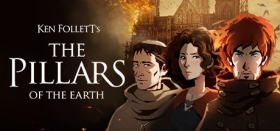
Ken Follett's The Pillars of the Earth - Book One Review
The Xbox One isn’t known for having a lot of notable visual novels. Besides the Telltale games, there really aren’t even that many story-centric games. I kept this in mind as I played through the first book of The Pillars of the Earth so that my critiques would be tailored to an experience with less gameplay than most titles. I was pleasantly surprised when I realised that The Pillars of the Earth replaces normal actions and activities with more cognitive gameplay. What I mean by this is that players are forced to think while they play The Pillars of the Earth. Puzzles can be solved in different ways that lead to different results (and consequences). Seemingly tiny choices can come back and make a real impact on the story during a key moment.
To avoid spoilers, I will give a hypothetical example. Imagine you’re talking to the local jailer and he tasks you with finding his keys. First, you may be given the option to accept the task or flat out ignore him, changing the story due to him not having his keys. If you take the task, you may find some clues by asking around or listening in on nearby conversations. Finally, depending on how you got the keys, you may be given the opportunity to report the jailer for losing his keys in the first place instead of simply returning the keys to the jailer. While this may not seem out of the ordinary, it’s how it affects the characters, how they interact with the player, and what it does to the story that is interesting. By giving the jailer the keys without reporting him, he may help you out later but reporting him may make him feel like you betrayed him while gaining favour with his boss.

Add to this the fact that the player will control three different characters that end up interacting with one another and affecting the story for each other and you end up with a deep, complicated experience. Since the player will control three different characters across the seven chapters of this first book, it quickly becomes clear that their relationship will be developed and tested by the time the game wraps up. While this concept may seem just kind of neat at first, actually going through this is very interesting since it creates moments of conflicting goals and opinions. As much as I would love to explain exactly what I mean, that would mean treading into spoiler territory again. Just trust me when I say that these moments of internal conflict are some of (if not) the best parts of The Pillars of the Earth.
By now, if you’ve played any adventure game where you collect items and figure out how to use them or any Telltale game, you can probably guess generally how this game plays out. You walk around, chatting with people to slowly pick up pieces of information or plot points to drive your characters ever forward. When you’re not talking to people, you’ll probably be picking up items to use later. Something interesting that The Pillars of the Earth does is make key topics or objectives useable items. Because of this, the player can attempt to talk to loads of people about a topic or ‘use’ that same idea on things in the environment to do various things. These actions could be examining the area, searching for an item, or several other tasks. This is different from other similar games and makes the title feel fresh and unique.

Breaking up this more slow, thoughtful gameplay, there are several ‘dexterity checks’ that are really just moments where the player has to hit A at the right time to succeed in doing an action. For me, this was most often using a slingshot correctly and accurately. Obviously, no other type of gameplay matches the importance and weight that the simple act of choosing dialogue options carries with it. Whether you’re explaining why building a cathedral is so important or deciding how to deal with an unruly character, what your character says can drastically alter how their tale unfolds. I wish that I could segue into the art of The Pillars of the Earth as well as that art helps portray the stories and struggles of each character in the game. While the art doesn’t always do things smoothly or elegantly, it does always present gritty and impressive visual representations of the unfolding narrative.
Although it isn’t always good at transitioning between moments or scenes, The Pillars of the Earth’s visual style mixes beautifully with the serious subjects the game tackles. Mix in some excellent voice acting and convincing sound design and you have an engaging experience that doesn’t ask you to finish it. It TELLS you to finish it. Unfortunately, only the first book, covering chapters 1-7, has been released so far. I’m eagerly awaiting the addition of the second and third books as future downloadable content. I feel like I should mention that I have not read the book that this title is based off, but I can say that it promises that events can be altered based on the choices the player makes throughout the story. To this end, I would assume even readers of the original book could find something interesting here.
Ken Follett's The Pillars of the Earth (Reviewed on Xbox One)
This game is great, with minimal or no negatives.
Through excellent dialogue choices, interesting item usage, and an immersive story, The Pillars of the Earth keeps the player interested from beginning to end. Becoming invested in the game's multiple protagonists is rewarded with a complex narrative that twists and turns to play with expectations.











COMMENTS